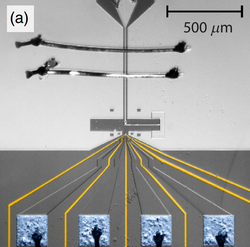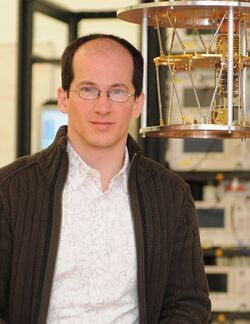Biography:Andreas Wallraff
Andreas Wallraff | |
|---|---|
Andreas Wallraff, January 2010 | |
| Nationality | German |
| Alma mater |
|
| Known for | Work on superconducting quantum computing.[1] Work with hybrid quantum systems involving Rydberg atoms and semiconductor quantum dots.[2][3] |
| Awards | Nicholas Kurti Science Prize for Europe (2006)[4] ETH Zürich Rössler Prize (2011)[5] |
| Scientific career | |
| Fields | Quantum information science, Superconducting quantum computing |
| Institutions | Swiss Federal Institute of Technology in Zurich |
| Theses | |
| Doctoral advisor | Alexey V. Ustinov |
| Website | https://www.qudev.ethz.ch/ |
Andreas Wallraff is a German physicist who conducts research in quantum information processing and quantum optics. He has taught as a professor at ETH Zürich in Zürich, Switzerland since 2006.[6] He worked as a research scientist with Robert J. Schoelkopf at Yale University from 2002 to 2005, during which time he performed experiments in which the coherent interaction of a single photon with a single quantum electronic circuit was observed for the first time.[7] His current work at ETH Zürich focuses on hybrid quantum systems combining superconducting electronic circuits with semiconductor quantum dots and individual Rydberg atoms as well as quantum error correction with superconducting qubits.[8]
He has contributed primarily to the field of quantum information science, particularly in superconducting quantum computing and hybrid quantum systems.[9]
Education and earlier work
Andreas Wallraff obtained his undergraduate degrees in physics from Imperial College London and RWTH Aachen University and conducted research on soliton dynamics in stacked Josephson tunnel junctions for his master's degree at the Forschungszentrum Jülich and RWTH Aachen, which he earned in 1997.[6][10][11] During his doctoral research on soliton and vortex dynamics in superconductors at the University of Erlangen-Nuremberg, he observed for the first time the tunneling and energy level quantization of an individual quantum vortex for which he obtained a PhD degree in physics in 2000.[12]
Following his doctoral research, Wallraff continued to work as a research scientist and later as an assistant professor at the University of Erlangen-Nuremberg.[11] In 2002, he left Europe to work as a postdoctoral researcher with Robert J. Schoelkopf within the Department of Applied Physics at Yale University in New Haven, Connecticut.[11] During this time, he was an author on papers regarding the coupling of superconducting qubits via a cavity bus and the coherent interaction of a single photon to a Cooper-pair box, among others.[7][13][14] In 2004 he was appointed as an associate research scientist in the Department of Applied Physics at Yale and in June 2005 he was elected as a tenure-track assistant professor at ETH Zürich.[11] Following the professorship appointment, he departed from Yale and started the Quantum Device Lab at ETH Zürich in January 2006.[9] In 2011, he was chosen from among 380 ETH Zürich professors to be awarded the Max Rössler Prize for his research activities.[9] In 2012, he worked as a visiting professor at the Kastler-Brossel Laboratory within the École Normale Supérieure in Paris, France.[6]
Research topics
Wallraff has in recent years been studying a variety of topics related to quantum information science. Among them include interactions between distant artificial atoms,[15] quantum many-body systems,[16] digital quantum simulation,[17] quantum nonlocality,[18] the implementation of the Toffoli gate in quantum computation,[19] deterministic quantum teleportation,[20][21] and the Hong-Ou-Mandel effect.[22]

In general, his research is primarily focused on investigating circuit QED (cQED) systems and their applications in superconducting quantum computing.[23] These include implementing quantum gates, identifying and eliminating sources of quantum decoherence to extend qubit lifetimes, and creating solid-state architectures in which quantum error correction is possible.[24] In addition, he conducts research into "hybrid quantum systems"; cQED systems interacting with Rydberg atoms and semiconductor quantum dots to combine "the long coherence times available in microscopic quantum systems with the strong interactions and integration available in solid state systems... [to allow] for strong interactions with control fields and thus fast manipulation of the quantum state of a system."[25]

Positions and speaking engagements
Since January 2006, Wallraff has held a professorship position at ETH Zürich where he is the head of the Quantum Device Lab within the Laboratory for Solid State Physics.[27] He has been awarded several grants, including two from the European Research Council (one in 2009 for hybrid cavity quantum electrodynamics and one in 2013 for superconducting quantum networks)[28] and holds positions as the President of the Strategy Commission for the Department of Physics and Deputy Head of the Laboratory for Solid State Physics at ETH Zürich.[29][30] He is also a member of the Scientific Committee for the Swiss National Science Foundation National Center of Competence in Research (NCCR) in Quantum Science and Technology (QSIT),[31] a member of the Global Future Council for the Future of Computing at the World Economic Forum,[32] and an Associate Fellow of the Canadian Institute for Advanced Research.[33]
Wallraff has been an invited speaker at several talks and conferences, including at the inaugural celebration for the Center for Quantum Coherence Science at the University of California, Berkeley,[34] The Optical Society "Quantum Information and Measurement - Quantum Technologies" meeting at the Pierre and Marie Curie University,[35] the IWQD 2017 workshop at the National Institute of Informatics,[36] and the 635th WE Heraeus Seminar[37] in 2017. In 2016 he spoke at the Institute of Physics Silicon Quantum Information Processing meeting at Murray Edwards College, Cambridge,[38] the University of Science and Technology of China,[39] and the SCALEQIT International Conference at the Delft University of Technology.[40]
In previous years he also spoke at the University of Oxford,[41] the Max Planck Institute for the Science of Light,[42] the Institute for Theoretical Atomic Molecular and Optical Physics (ITAMP) 2015 workshop at Harvard University,[43] and the Kavli Institute for Theoretical Physics at the University of California, Santa Barbara.[44]
References
- ↑ A. Blais, R.- S. Huang, A. Wallraff, S. M. Girvin, and R. J. Schoelkopf, "Cavity quantum electrodynamics for superconducting electrical circuits: An architecture for quantum computation", Physical Review A 69, 062320 (2004), doi:10.1103/PhysRevA.69.062320
- ↑ S. D. Hogan, J. A. Agner, F. Merkt, T. Thiele, S. Filipp, and A. Wallraff, "Driving Rydberg-Rydberg Transitions from a Coplanar Microwave Waveguide", Physical Review Letters 108, 063001 (2012), doi:10.1103/PhysRevLett.108.063004
- ↑ T. Frey, P. J. Leek, M. Beck, A. Blais, T. Ihn, K. Ensslin, and A. Wallraff, "Dipole Coupling of a Double Quantum Dot to a Microwave Resonator", Physical Review Letters 108, 046807 (2012), doi:10.1103/PhysRevLett.108.046807
- ↑ "The Nicholas Kurti Science Prize for Europe". https://www.oxford-instruments.com/businesses/nanotechnology/nanoscience/nicholas-kurti-european-science-prize.
- ↑ "Rössler Prize". https://www.ethz.ch/en/research/science-awards-and-events/roessler-prize.html.
- ↑ 6.0 6.1 6.2 "Quantum Device Lab". https://qudev.ethz.ch/andreas_wallraff.
- ↑ 7.0 7.1 A. Wallraff, D. I. Schuster, A. Blais, L. Frunzio, R.- S. Huang, J. Majer, S. Kumar, S. M. Girvin, and R. J. Schoelkopf, "Strong coupling of a single photon to a superconducting qubit using circuit quantum electrodynamics", Nature 431, 162-167 (2004), doi:10.1038/nature02851
- ↑ "Quantum Device Lab Research Topics". https://www.qudev.ethz.ch/research%20topics.
- ↑ 9.0 9.1 9.2 "Auf dem Weg zum Schweizer Supercomputer". Tages-Anzeiger. 2011-06-28. http://www.tagesanzeiger.ch/digital/computer/Auf-dem-Weg-zum-Schweizer-Supercomputer/story/25692897.
- ↑ "Fluxon Dynamics and Radiation Emission in Twofold Long Josephson Junction Stacks". 1997-01-27. http://qudev.phys.ethz.ch/content/science/thesis/dipl_wallraff.pdf.
- ↑ 11.0 11.1 11.2 11.3 "Wallraff, Andreas, Prof. Dr.". http://www.first.ethz.ch/people/people-a-z/person-detail.html?persid=134453.
- ↑ "Fluxon Dynamics in Annular Josephson Junctions: From Relativistic Strings to Quantum Particles". 2000-07-18. http://qudev.ethz.ch/content/science/thesis/dr_wallraff.pdf.
- ↑ J. Majer, J. M. Chow, J. M. Gambetta, J. Koch, B. R. Johnson, J. A. Schreier, L. Frunzio, D. I. Schuster, A. A. Houck, A. Wallraff, A. Blais, M. H. Devoret, S. M. Girvin, and R. J. Schoelkopf, "Coupling superconducting qubits via a cavity bus", Nature 449, 443-447 (2007), doi:10.1038/nature06184
- ↑ "All Aboard the Quantum 'Bus'". 2007-09-27. https://www.photonics.com/Article.aspx?AID=30972.
- ↑ A. F. van Loo, A. Fedorov, K. Lalumière, B. C. Sanders, A. Blais, and Andreas Wallraff, "Photon-Mediated Interactions Between Distant Artificial Atoms", Science 342, 6165, 1494-96 (2013), doi:10.1126/science.1244324
- ↑ C. Eichler, J. Mlynek, J. Butscher, P. Kurpiers, K. Hammerer, T. J. Osborne, and A. Wallraff, "Exploring Interacting Quantum Many-Body Systems by Experimentally Creating Continuous Matrix Product States in Superconducting Circuits", Physical Review X 5, 041044 (2015), doi:10.1103/PhysRevX.5.041044
- ↑ Y. Salathé, M. Mondal, M. Oppliger, J. Heinsoo, P. Kurpiers, A. Potočnik, A. Mezzacapo, U. Las Heras, L. Lamata, E. Solano, S. Filipp, and A. Wallraff, "Digital Quantum Simulation of Spin Models with Circuit Quantum Electrodynamics", Physical Review X 5, 021027 (2015), doi:10.1103/PhysRevX.5.021027
- ↑ M. Jerger, Y. Reshitnyk, M. Oppliger, A. Potočnik, M. Mondal, A. Wallraff, K. Goodenough, S. Wehner, K. Juliusson, N. K. Langford, and A. Fedorov, "Contextuality without nonlocality in a superconducting quantum system", Nature Communications 7, 12390 (2016), doi:10.1038/ncomms12930
- ↑ A. Fedorov, L. Steffen, M. Baur, M. P. da Silva, and A. Wallraff, "Implementation of a Toffoli gate with superconducting circuits", Nature 481, 170-172 (2012), doi:10.1038/nature10713
- ↑ L. Steffen, Y. Salathe, M. Oppliger, P. Kurpiers, M. Baur, C. Lang, C. Eichler, G. Puebla-Hellmann, A. Fedorov and A. Wallraff, "Deterministic quantum teleportation with feed-forward in a solid state system", Nature 500, 319-322 (2013), doi:10.1038/nature12422
- ↑ "Teleportation: Behind the Science of Quantum Computing". 2013-08-14. http://news.nationalgeographic.com/news/2013/08/130814-physics-quantum-computing-teleportation-star-trek-qubit-science/.
- ↑ C. Lang, C. Eichler, L. Steffen, J. M. Fink, M. J. Woolley, A. Blais, and A. Wallraff, "Correlations, indistinguishability and entanglement in Hong–Ou–Mandel experiments at microwave frequencies", Nature Physics 9, 345-348 (2013), doi:10.1038/nphys2612
- ↑ "Research Topics". https://www.qudev.ethz.ch/research%20topics.
- ↑ "Quantum Information Processing". https://www.qudev.ethz.ch/research_topics/quantum_information_processing.
- ↑ "Hybrid Quantum Systems". https://www.qudev.ethz.ch/research_topics/hybrid_quantum_systems.
- ↑ A. Stockklauser, P. Scarlino, J. V. Koski, S. Gasparinetti, C. K. Andersen, C. Reichl, W. Wegscheider, T. Ihn, K. Ensslin, and A. Wallraff, "Strong Coupling Cavity QED with Gate-Defined Double Quantum Dots Enabled by a High Impedance Resonator", Physical Review X 7, 011030 (2017), doi:10.1103/PhysRevX.7.011030
- ↑ "Wallraff, Andreas, Prof. Dr.". http://www.solid.phys.ethz.ch/people/person-detail.html?persid=134453.
- ↑ "ERC Funded Projects". https://erc.europa.eu/projects-figures/erc-funded-projects/results?search_api_views_fulltext=andreas+wallraff.
- ↑ "Department Management and Administration". https://www.phys.ethz.ch/the-department/management.html.
- ↑ "Andreas Wallraff". https://www.bi.id.ethz.ch/personensuche/personenDetail.view?page=1&lang=en&schnellSuche=andreas+wallraff&order=NAME&descending=false&paging=true&pid=20d35.
- ↑ "National Centres of Competence in Research". p. 52. http://www.snf.ch/SiteCollectionDocuments/nfs/nccr_guide_2017.pdf.
- ↑ "The Future of Computing". https://www.weforum.org/communities/the-future-of-computing.
- ↑ "CIFAR". https://www.cifar.ca/profiles/andreas-wallraff/.
- ↑ "Center for Quantum Coherent Science". 2017-01-09. http://live-cqcs.pantheon.berkeley.edu/fiqcs/program/.
- ↑ "OSA Quantum Information and Measurement". http://www.osa.org/en-us/meetings/topical_meetings/quantum_information_and_measurement_(qim)_-_iv_qu/invited_speakers/.
- ↑ "IWQD 2017". http://home.hiroshima-u.ac.jp/mhirokaw/iwqd/iwqd2017/program.html.
- ↑ "IBM 635th WE-Heraeus Seminar". 2017-01-31. https://www.zurich.ibm.com/heraeus/program_tues.html.
- ↑ "IOP Silicon Quantum Information Processing 2016". 2017-01-31. http://siqip2016.iopconfs.org/speakers.
- ↑ "The International Conference on Quantum Foundation and Technology". 2016-11-16. http://quantum.ustc.edu.cn/icqft/uploads/ICQFT2016_Program6.pdf.[yes|permanent dead link|dead link}}]
- ↑ "Delft SCALEQIT 2016". https://www.chalmers.se/SiteCollectionDocuments/Mikroteknologi%20och%20Nanovetenskap/ScaleQIT.pdf.
- ↑ "QISW 2012 Workshop Program". 2012-03-30. http://www.cs.ox.ac.uk/qisw2012/program.html.
- ↑ "MPL Distinguished Lecturer Series". 2014-05-08. http://www.mpl.mpg.de/en/institute/news/news/article/mpl-distinguished-lecturer-series-prof-andreas-wallraff.html.
- ↑ "Light Matter Interactions in Low Dimensions". 2015-06-29. https://www.cfa.harvard.edu/itamp-event/light-matter-interactions-low-dimensions.
- ↑ "Non-equilibrium Dynamics of Strongly Interacting Photons". 2015-10-07. http://online.kitp.ucsb.edu/online/denselight_c15/.
External links


